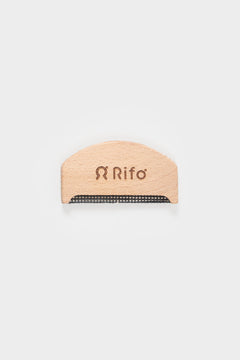The dyeing of textile fibers is perhaps the most polluting process in the fashion industry. It requires a lot of water and the use of chemicals that have a negative impact on the environment.
That’s why Rifò’s adventure in the world of sustainable fashion began from recycled cashmere and denim fibers. This type of material comes from old garments that are sorted by color and therefore do not need a re-dyeing phase.
Dyeing only turned out to be unavoidable when we started working with recycled cotton, which is obtained from raw industrial waste instead of old garments.
After using the first traditional chemical-based dyes, we felt the need to question yourselves about sustainable alternatives.
Thus a new capsule was born, featuring garments dyed without resorting to synthetic substances. We opted for naturally available pigments, which guarantee a garment greater biodegradability Plant-based ones are obtained from peach pits, blueberries and chlorophyll, while mineral-based dyes are derived from volcanic soils of the Mediterranean area.

After delving deep into the subject, we're excited to share with you all the fascinating things we've learned about textile dyeing processes. From sustainable options to less eco-friendly practices, we'll explore the benefits and drawbacks of natural dyes versus more commonly used techniques.
- 1 What are natural dyes?
- 2 Textile natural and chemical-based dyeing: all the differences
- 3 The Water Impact of Textile Dyeing
- 4 Natural dyes and biodegradability
- 5 The impacts on workers' health
- 6 What are the synthetic fabric dyes with the most negative impact?
- 7 Pros and cons of natural dyes
- 8 Natural dyed garments by Rifò
What are natural dyes?
Natural dyes are pigments of various colors extracted or derived from resources found in nature. They can come from organic plant, animal, or mineral sources.
Animal-derived colorants have been used since ancient times, with examples including cochineal extracted from the shell of an insect, and purple dye sourced from a marine mollusk. Indigo is an example of a plant-derived dye, with the blue pigment obtained from the maceration of the leaves of the plant. Historically, it has been used for the dyeing of denim fabric. Mineral dyes, on the other hand, are powders directly sourced from rocks and earth, such as ochre, which derives its characteristic yellow color from iron oxide.

Dyeing with natural pigments involves differences in the process and results compared to synthetic pigment dyeing, making these techniques suitable only for small-scale productions that are difficult to standardize. As a result, they are unsustainable for fast fashion and large-scale productions. This is why this type of processing still seems to be immune to greenwashing.
Textile natural and chemical-based dyeing: all the differences
The process:
From a process standpoint, the various steps to be followed to dye fabrics using natural pigments are not very different from those used for synthetic colors.
Any dyeing process, whether natural or synthetic, typically involves four stages, all of which require the use of water:
• Scouring: the fabric is washed to purify it from any impurities that would prevent the color from adhering.
• Fixative: the application of a mordant that helps the color bond with the fibers.
• Dyeing: fabric and color are inserted into the machine, and the actual dyeing of the garment occurs through a passage in water at high temperatures, which can vary depending on the material and the dyeing process.
• Rinsing: the phase in which the now-dyed fabric is rinsed to remove any excess color. In this step, it is important to manage the substances used for dyeing correctly, as they will end up in the wastewater. Today, there are water purification systems that help limit the dispersion of harmful chemicals in the ecosystem.
However, it is precisely in this step that the greatest advantage of natural dyes is found. Since they are completely biodegradable, they have zero impact on groundwater.

So, where does the difference between natural and synthetic dyeing lie?
Craftsmanship. Natural dyes are powders that must be correctly dosed, and this involves many more manual steps than chemical dyes. The work is carried out using elements that are less controllable and more subject to irregularities and imperfections, compared to the use of chemical compounds created in the laboratory specifically for the purpose of coloring fabrics.
In addition, natural pigment-based dyebaths are possible only for small quantities of fabric, typically ranging from 5 to 10 kg, which makes these processes impossible on a large scale.
The result:
Natural dyes result in a limited range of pastel colors and, unlike synthetic dyes, they can never achieve bright and saturated colors.
This is because natural pigments cover the fibers instead of chemically bonding to them.
For this reason, natural dyes will always have delicate and slightly uneven shades, as each result is unique.
Using naturally available dyes, as opposed to those created in a standard way in the laboratory, involves a margin of unpredictability in the final result, making each garment unique.
Unpredictability also has to do with color fastness.
Color fastness refers to a fabric's ability to remain intact over time and not be altered by external agents such as water and light.
Although excellent outcomes can be achieved with natural dyes, results of this process in terms of color fastness may not be as resistant as those of synthetic dyes.
The passage of time and washing will indeed have an effect on natural coloring, but we think that the changes on a garment’s surface only help reveal its story.

The Water Impact of Textile Dyeing
Water consumption
As we have previously mentioned, textile dyeing requires a significant amount of water. It is difficult to estimate the exact amount needed, as it depends on several variables such as the type of fabric to be dyed, the substances used in the process, and the desired outcome.
However, we can get a rough idea by considering a material to dyebath ratio ranging from 1:20 to 1:40 for any dyeing process that involves water. This means that to dye 1 kg of fabric, which equals approximately two pairs of pants, several steps (at least four: scouring, fixing, dyeing, and rinsing) requiring 20 to 40 liters of water each are necessary, resulting in a total water consumption ranging from 80 to 160 liters.

Water consumption is not the only impact of textile dyeing. The substances used in the process often end up in wastewater and consequently in the sea.
In Prato, one of the largest textile districts in Italy, during the economic boom years, it was said that one could tell the trending colors by looking at the color of the Bisenzio River.
However, things have changed a lot since then, and many steps have been taken to protect the environment from such a impactful process. Various water treatment consortia, have been established to allow textile dyeing factories in the district to reuse purified recycled water.
If we acknowledge the effort required to protect the environment from the substances used in synthetic textile dyeing, using natural dyes becomes incredibly valuable. Even in cases where these substances end up in the sea, for example, they would not have a negative impact on ecosystems.

Natural dyes and biodegradability
If garments dyed using natural pigments don't pollute during production, they won't pollute at the end of their life cycle either.
To discuss the biodegradability of a garment, we need to consider at least two aspects: its composition, which must be natural and pure, and which dyes have been used.
Natural dyes will help ensure that the garment does not release harmful substances into the environment, even if it is abandoned for years and left to biodegrade in the soil.
The impacts of fabric dyes on workers' health
When we visited the dyeing factories that handle our natural dyes, we realized what it means to dye fabrics.
In a dyeing factory, you will find many large washing and drying machines, and each one carries out a specific phase of the process. Despite being an industrial process, human intervention is still necessary to move the work from one machine to another and set the dye dosage correctly.

As with any job that involves constant contact with potentially harmful chemicals, health risks require the use of protective equipment.
During our visits, we noticed that people constantly work wearing a mask, and there is great attention paid to complying with health regulations to prevent the risk of work-related illnesses, such as skin cancer, dermatitis, respiratory and mucous membrane infections.
We can only imagine what happens in a dyehouse in a Far East Asian country, where there are no protections for workers and fast fashion decides to bring in its own productions. For this reason as well, promoting the use of natural dyes and introducing them to the market seemed like the right path to take.
What are the synthetic fabric dyes with the most negative impact?
Well, not all colors are created the same way and some are indeed more impactful than others. While it's worth noting that processes can vary greatly and there are dozens and dozens of different dyeing agents, we can say that dark colors usually require the most energy, water, and resources.

This is because dark colors or even very bright ones require longer and hotter washes compared to light colors. Additionally, they call for a higher concentration of synthetic chemical dyes.
The impact of coloring also varies depending on the materials to be dyed. To dye polyester, for example, a temperature ranging between 118 and 135 degrees under pressure is required, while for traditional cotton dyeing, 90° is sufficient.
Summing up: advantages and disadvantages of natural and chemical dyes
Here's a short list that helps us understand the main advantages and disadvantages of natural and chemical dyes in textiles:
Natural dyes:
• Biodegradability
• Partially hand-crafted process, not easily industrialized
• Difficulty in reproducing the exact same color on a large scale
• Pastel colors with a unique effect
• High cost
Dyes based on synthetic colors:
• Negative impact on garment's biodegradability
• Easily industrialized and reproducible on a large scale
• Possibility of making any color
• Low production cost
Rifò's natural dyed garments
Did you see our capsule of garments dyed using mineral dyes from volcanic soils and silk garments from plant-based colors?
These biodegradable dyes are produced in Italy and the Mediterranean area and are only possible for small dyebaths and small production runs.
The Elettra and Brando pants, the Gemma dress, and the Renza and Realma twin set are now available for pre-order at a special price, as we strive to produce only what is necessary and further reduce our impact on the environment.
Have a look ⇩












